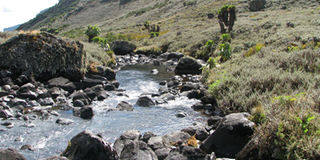Prime
The waning beauty of Mt. Elgon

River Soloko, once a blossoming river, has been reduced to a stream. PHOTO BY DAVID MAFABI
Many years ago, Mt. Elgon slopes were green, animals enjoyed their habitat and the rivers flowed gently on its slopes. However, all that has changed, writes DAVID MAFABI.
As we prepare to depart from River Soloko in Bumasifwa on the slopes of Mt. Elgon, which is one of the rivers flowing from the Mt Elgon area in Sironko, Mr Charles Giduno, our tour guide, takes a look across the segmented river in a contemplative mood.
Mr Giduno stood straight in front of us as children and women went past us carrying firewood, mushrooms, bamboo shoots, vegetables, firewood while the men carried timber. He looked at all these people in disbelief; it was as though the entire strength had gone out of him. Then as a sigh of relief, he guided us slowly along empty paths, past willows and scattered forest trees, to “Jackson’s hole of death”, where we could clearly see the hitherto fertile valley, beautiful scenery as small rivers meandered downhill.
“Like many of the rivers that flow from Mt. Elgon, River Soloko used to be big and was filled up with water throughout the year but it is now just no more,” he says.
Paul Gidongo, who works with the Mt. Elgon Conservation Tourism Information Centre as a guide, believes that most of the rivers that provided a livelihood to about 500,000 people in Bugisu and Sebei sub-regions face extinction due to a combination of several factors, especially as a result of anti-environmental human activities like deforestation and poor farming methods.
“The rivers have become streams and have dried up. Soon the rivers will disappear because of human activity. People are farming on the slopes where the rivers flow from. This will make the rivers recede in size. We are going to lose the rivers and the entire beauty of Mt. Elgon,” said Mr Gidongo.
Mr Gidongo says Mt. Elgon ecosystem which provides a catchment area for lakes Victoria and Turkana and River Nile, was a home for about 400 elephants, antelopes, leopards and the protected columbus and blue monkeys, some buffaloes, giant forest hogs and waterbucks.
But that ever since encroachment took precedence over conservation, most of these are disappearing, pausing a threat to the tourism industry here. “Although the mountain is covered by red laterite soils which favours the growth of thick undergrowth, the huge Elgon teak and cedar trees, man has cut these down to secure land for settlement and farming to the disservice of the functions of the big mountain. I think environmental degradation on the mountain calls for immediate conservation interventions,” says Mr Gidongo.
According to the Mt. Elgon Conservation Area Manager, Mr Adonia Bintorwa, the park neighbours (encroachers) have mercilessly hunted down wildlife for game meat, cut down trees for timber and settlement and farming thereby scaring away the valuable birds and animals that are a major target for tourists.
He revealed that records at the Uganda Wildlife Authority reveal that the dykers, buffaloes, leopards, red tailed monkeys, antelopes and birds hitherto potential tourist attractions have all escaped to the Kenya side of the mountain due to massive destruction of their habitat. The fauna has not been spared too and some species are now at the brink of extinction.
“Of course clearances of the park forest for settlement and farming has seen destruction of traditional medicinal trees like Prunus Africana, Fagalopsis, Spathodea and Olea which are as old as 300 years. This poses a great danger of extinction of the great traditional medicinal tree species,” said Mr Bintorwa.
Soaring encroachment
Field work survey reports and research done by UWA indicates that the encroachment has soared to about 25,000 hectares as far as high altitude plants called Lubelia signaling great danger of environmental catastrophe for Pallisa, Budaka, Tororo and Butaleja districts, which are found in the plains.
Mr Richard Matanda, the conservation area manager at Mt Elgon National Park, says setting up of farmlands inside the national park is a major threat to the Mt Elgon eco-system.
An encroachment report by UWA adds that an ecological system promotes opportunities for nature watching, hunting, wild flower viewing and other recreational activities and that all most of these activities are declining due to encroachment.
According to Mr Bintorwa, the forest soils have adequate physical, biological and chemical properties to maintain and improve vegetation growth, hydrologic functions, nutrients cycling and slope stability.
Mr Bintorwa adds that soil productivity is sustained through nitrogen and carbon dioxide fixation, mineral release from weathering parent materials, coarse debris and other decaying matter and translocation of nutrients and that all this is reducing because of encroachment along the steep slopes of Mt Elgon.
“The increasing incidents of landslides in the upper encroached hills of Mt Elgon and flooding downstreams, high incidences of malaria, recurring incidents of incessant rainfall and threats of biodiversity indicate that human life living around the mountain is in danger if government does not develop guidelines for sustaining the ecological diversity at Mt Elgon,” said Mr Bintorwa.
Ecological study
An ecological study carried out by UWA and National Water and Sewerage Corporation indicates that although most rivers that flow from Mt. Elgon National Park are drying up, the water from most of the rivers is equally now unsafe for consumption once untreated. The study report says the water quality analysis from selected rivers at the national park reveals that massive encroachment beyond the bamboo zone were endangering the ecological functions of Mt. Elgon at a great rate thereby providing a perfect recipe for an environmental catastrophe.
“Four of the rivers’ samples taken inside the park and its boundaries for physico-chemical and bacterial examination, showed that due to massive encroachment the rivers had a high number of dissolved solids that contaminated the waters,” reads the report.
Most contaminated
The report further says River Manafwa that supplies water to Mbale Municipality, Tororo, Busia and Butaleja has the most contaminated water. The other affected rivers are Chebonet in Kapchorwa and Sisiyi.
The Minister in-charge of General Duties, Ms Janet Mukwaya, who was on the tour of the park to seek a lasting solution for the encroachers recently evicted from there, said Mt. Elgon zone districts used to receive rainfall as early as late January but that that ever since the increase in encroachment, the rainfall patterns have reduced, streams have dried and big rivers have turned into streams.
She revealed that Elgon zone stands prone to heavy landslides, mudslides, massive soil erosion and desertification if the encroachment is not checked now. Local geographers have said Bugisu and Sebei region’s fertile soils are being eroded into River Nile, Lake Kyoga and various swamps in the low-lying areas without control because of the destruction of the vegetation cover at Mt Elgon Park areas.



